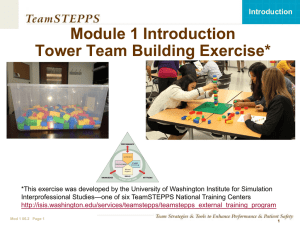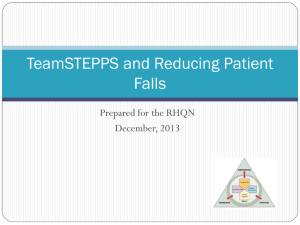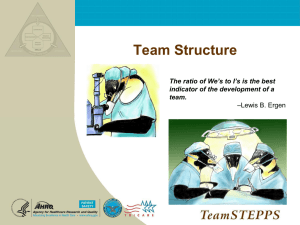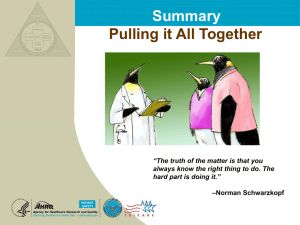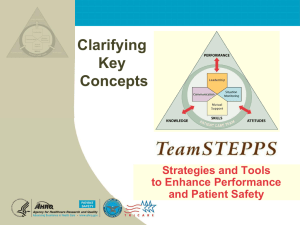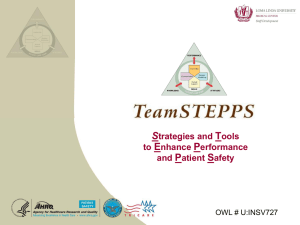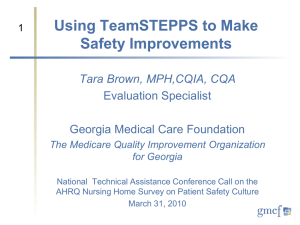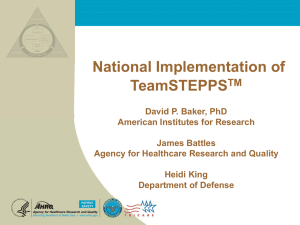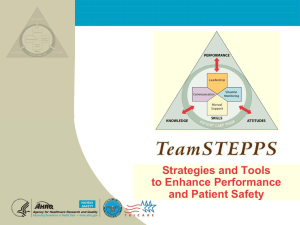Introduction - K
advertisement
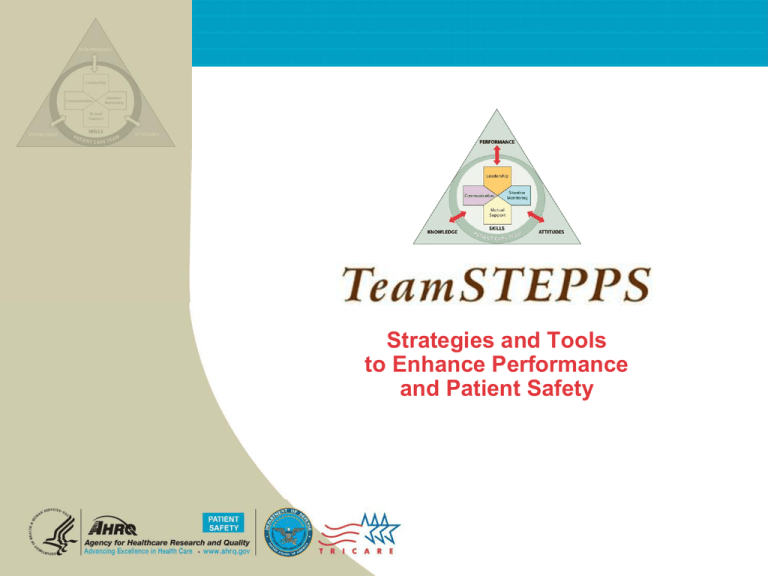
Strategies and Tools to Enhance Performance and Patient Safety Introduction Objectives Describe the TeamSTEPPS training initiative Explain your organization’s patient safety program Describe the impact of errors and why they occur Describe the TeamSTEPPS framework State the outcomes of the TeamSTEPPS framework Mod 1 06.2 05.2 Page 2 TEAMSTEPPS 05.2 2 Introduction Joint Commission Sentinel Events Mod 1 06.2 05.2 Page 3 TEAMSTEPPS 05.2 3 Introduction OR Teamwork Climate and Postoperative Sepsis Rates Length of ICU Stay After Team Training (per 1000 discharges) 18 2.4 Avg. Length of Stay (days) 16 2.2 14 50 2 1.8 % Group Mean 12 Re du cti on AHRQ National Average 10 Low Teamwork Climate 8 1.6 Mid Teamwork Climate 6 1.4 4 High Teamwork Climate 1.2 2 1 June July August Sept Oct Nov Dec Jan Feb March April 0 May Teamwork Climate Based on Safety Attitudes Questionnaire (Sexton, 2006) Johns Hopkins (Pronovost, 2003) Johns Hopkins Journal of Critical Care Medicine Adverse Outcomes Low High Indemnity Experience Pre-Teamwork Training Post-Teamwork Training 25 20 50% Reduction 20 50% Reduction 15 11 10 5 0 (Mann, 2006) Beth Israel Deaconess Medical Center Contemporary OB/GYN Mod 1 06.2 05.2 Page 4 Malpractice Claims, Suits, and Observations TEAMSTEPPS 05.2 4 Introduction Team Strategies & Tools to Enhance Performance & Patient Safety “Initiative based on evidence derived from team performance…leveraging more than 25 years of research in military, aviation, nuclear power, business and industry…to acquire team competencies” Mod 1 06.2 05.2 Page 5 TEAMSTEPPS 05.2 5 Introduction The Components of a Patient Safety Program Mod 1 06.2 05.2 Page 6 TEAMSTEPPS 05.2 6 Introduction What Comprises Team Performance? Knowledge Cognitions “Think” Attitudes Affect “Feel” Skills Behaviors “Do” Mod 1 06.2 05.2 Page 7 TEAMSTEPPS 05.2 …team performance is a science…consequences of errors are great… 7 Team Structure NEXT: The ratio of We’s to I’s is the best indicator of the development of a team. –Lewis B. Ergen Introduction What Defines a Team? Two or more people who interact dynamically, interdependently, and adaptively toward a common and valued goal, have specific roles or functions, and have a time-limited membership Mod 1 06.2 05.2 Page 9 TEAMSTEPPS 05.2 9 Introduction High-Performing Teams Teams that perform well: Hold shared mental models Have clear roles and responsibilities Have clear, valued, and shared vision Optimize resources Have strong team leadership Engage in a regular discipline of feedback Develop a strong sense of collective trust and confidence Create mechanisms to cooperate and coordinate Manage and optimize performance outcomes (Salas et al. 2004) Mod 1 06.2 05.2 Page 10 TEAMSTEPPS 05.2 10 Introduction Multi-Team System (MTS) for Patient Care Mod 1 06.2 05.2 Page 11 TEAMSTEPPS 05.2 11 Leadership Introduction Effective Team Leaders Organize the team Articulate clear goals Make decisions through collective input of members Empower members to speak up and challenge, when appropriate Actively promote and facilitate good teamwork Skillful at conflict resolution Mod 1 06.2 05.2 Page 13 TEAMSTEPPS 05.2 13 Introduction Resource Management Core Team Leader Coordinating Team Leader • Information • Information – Patient & Family – Plan of care – Facilities Administrative – Facilities • Time • Equipment • Time • Equipment • Patient flow HUMAN CAPITAL FOCUS Team & Your Unit Mod 1 06.2 05.2 Page 14 • Other departments FOCUS Support Units TEAMSTEPPS 05.2 14 Introduction Delegation Method of re-distributing tasks or assignments Process includes 4 steps: Decide what to delegate Decide to whom to delegate Communicate clear expectations Request feedback Mod 1 06.2 05.2 Page 15 TEAMSTEPPS 05.2 15 Introduction Promoting & Modeling Teamwork Effective leaders cultivate desired team behaviors and skills through: Mod 1 06.2 05.2 Page 16 Open sharing of information Role modeling and effectively cueing team members to employ prescribed teamwork behaviors and skills Constructive and timely feedback Facilitation of briefs, huddles, debriefs, and conflict resolution TEAMSTEPPS 05.2 16 Introduction Team Events Briefs – planning Huddles – problem solving Debriefs – process improvement Leaders are responsible to assemble the team and facilitate team events But remember… Anyone can request a brief, huddle, or debrief Mod 1 06.2 05.2 Page 17 TEAMSTEPPS 05.2 17 Introduction Teamwork Actions Empower team members to speak freely and ask questions Utilize resources efficiently to maximize team performance Balance workload within the team Delegate tasks or assignments, as appropriate Conduct briefs, huddles, and debriefs Utilize conflict resolution techniques (i.e., Two-Challenge rule and DESC script) Mod 1 06.2 05.2 Page 18 TEAMSTEPPS 05.2 18 Situation Monitoring “Attention to detail is one of the most important details ...” –Author Unknown Introduction A Continuous Process Situation Monitoring (Individual Skill) Situation Awareness (Individual Outcome) Shared Mental Model (Team Outcome) Mod 1 06.2 05.2 Page 20 TEAMSTEPPS 05.2 20 Introduction Components of Situation Monitoring: Mod 1 06.2 05.2 Page 21 TEAMSTEPPS 05.2 21 Introduction Situation Awareness is… The state of knowing the current conditions affecting the team’s work Mod 1 06.2 05.2 Page 22 Knowing the status of a particular event Knowing the status of the team’s patients Understanding the operational issues affecting the team Maintaining mindfulness TEAMSTEPPS 05.2 22 Introduction Conditions that Undermine Situation Awareness (SA) Failure to— Mod 1 06.2 05.2 Page 23 Share information with the team Request information from others Direct information to specific team members Include patient or family in communication Utilize resources fully (e.g., status board, automation) Document TEAMSTEPPS 05.2 23 Introduction A Shared Mental Model is… The perception of, understanding of, or knowledge about a situation or process that is shared among team members through communication. “Teams that perform well hold shared mental models.” (Rouse, Cannon-Bowers, and Salas 1992) Mod 1 06.2 05.2 Page 24 TEAMSTEPPS 05.2 24 Introduction Shared Mental Model? Mod 1 06.2 05.2 Page 25 TEAMSTEPPS 05.2 25 Introduction Teamwork Actions Conduct team exercises to increase situation monitoring skills Share information in a timely fashion Include patient and/or family in communication Use cross monitoring Apply the STEP process when monitoring the situation Foster communication to ensure that all members of the team have a shared mental model Share information during briefs, team huddles, debriefs, and transitions in care “Teams do not seek consensus; they seek the best answer.” –Katzenbach and Smith Mod 1 06.2 05.2 Page 26 TEAMSTEPPS 05.2 26 Mutual Support “A chain is only as strong as its weakest link.” –Author Unknown Introduction Mutual Support Mutual support is the essence of teamwork Mod 1 06.2 05.2 Page 28 Protects team members from work overload situations that may reduce effectiveness and increase the risk of error TEAMSTEPPS 05.2 28 Introduction Task Assistance Team members foster a climate in which it is expected that assistance will be actively sought and offered as a method for reducing the occurrence of error. “In support of patient safety, it’s expected!” Mod 1 06.2 05.2 Page 29 TEAMSTEPPS 05.2 29 Introduction Characteristics of Effective Feedback Good Feedback is— TIMELY RESPECTFUL SPECIFIC DIRECTED toward improvement Helps prevent the same problem from occurring in the future CONSIDERATE “Feedback is where the learning occurs.” Mod 1 06.2 05.2 Page 30 TEAMSTEPPS 05.2 30 Introduction Advocacy and Assertion Advocate for the patient Invoked when team members’ viewpoints don’t coincide with that of a decision maker Assert a corrective action in a firm and respectful manner Mod 1 06.2 05.2 Page 31 TEAMSTEPPS 05.2 31 Introduction Conflict Resolution Options Information Conflict (We have different information!) Personal Conflict (Hostile and harassing behavior) Two-Challenge rule DESC script Mod 1 06.2 05.2 Page 32 TEAMSTEPPS 05.2 32 Introduction Please Use CUS Words but only when appropriate! Mod 1 06.2 05.2 Page 33 TEAMSTEPPS 05.2 33 Introduction Conflict Resolution DESC Script A constructive approach for managing and resolving conflict D—Describe the specific situation E—Express your concerns about the action S—Suggest other alternatives C—Consequences should be stated Ultimately, consensus shall be reached. Mod 1 06.2 05.2 Page 34 TEAMSTEPPS 05.2 34 Introduction Teamwork Actions Foster a climate supportive of task assistance Provide timely and constructive feedback Be assertive and advocate for the patient Use the Two-Challenge rule, CUS, and DESC script to resolve conflict Resolve conflict through collaboration—Create a “Win-Win-Win” situation “Those whom we support hold us up in life.” –Marie von Ebner-Eschenbauch Mod 1 06.2 05.2 Page 35 TEAMSTEPPS 05.2 35 Communication Assumptions Fatigue Distractions HIPAA Introduction Standards of Effective Communication Complete Communicate all relevant information Clear Convey information that is plainly understood Brief Communicate the information in a concise manner Timely Mod 1 06.2 05.2 Page 37 Offer and request information in an appropriate timeframe Verify authenticity Validate or acknowledge information TEAMSTEPPS 05.2 37 Introduction Call-Out is… A strategy used to communicate important or critical information It informs all team members simultaneously during emergency situations It helps team members anticipate next steps …On your unit, what information would you want called out? Mod 1 06.2 05.2 Page 38 TEAMSTEPPS 05.2 38 Introduction Check-Back is… Mod 1 06.2 05.2 Page 39 TEAMSTEPPS 05.2 39 Introduction Handoff Optimized Information Responsibility– Accountability Uncertainty Verbal Structure Checklists IT Support Acknowledgement Great opportunity for quality and safety Mod 1 06.2 05.2 Page 40 TEAMSTEPPS 05.2 Introduction Teamwork Actions Communicate with team members in a brief, clear, and timely format Seek information from all available sources Verify and share information Practice communication tools and strategies daily (SBAR, call-out, check-back, handoff) Mod 1 06.2 05.2 Page 41 TEAMSTEPPS 05.2 41 Introduction Pulling it All Together Recognize opportunities to improve patient safety Assess your current organizational culture and existing Patient Safety Program components Identify teamwork improvement action plan by analyzing data and survey results Design and implement initiative to improve team- related competencies among your staff Integrate TeamSTEPPS into daily practice. “High-performance teams create a safety net for your healthcare organization as you promote a culture of safety." Mod 1 06.2 05.2 Page 42 TEAMSTEPPS 05.2 42
